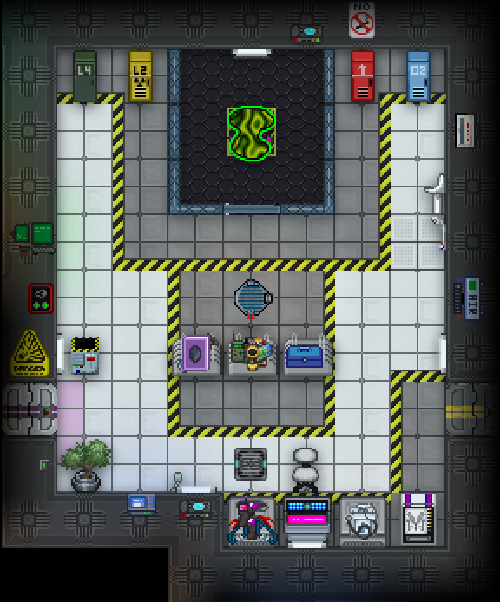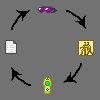Guide to Artifacts
Hey, this page is semi-outdated! If you're playing on a test merge with the new changes, check out this WIP page instead! https://wiki.beestation13.com/view/User:Racc-Off/new_artifacts

What's an Artifact?
Artifacts are strange objects that can perform unique & powerful actions. These items can be researched and sold for a profit, if you're diligent enough. Artifacts come in multiple flavours, material types, that indicate their function, and can often be quite dangerous.
Artifacts can be bought & sold from the Research and Development Listing Console, or found in maintenance, lavaland, or exploration ruins.
It's important to keep in mind, selling artifacts is pointless unless they are labeled correctly. Artifacts have a set amount of unique aspects, and the majority of these have to be correctly identified and labeled, to make a profit when selling the artifact. You can think of this process as a complex, life risking, game of guess-who. You can use tools, like anti-tactile pinchers, to make this process easier.



 Artifacts are strange powerful items that can do practically anything!
Artifacts are strange powerful items that can do practically anything! Use the Research and Development Listing Console to buy & sell artifacts.
Use the Research and Development Listing Console to buy & sell artifacts. Use the Artifact Labeler to
Use the Artifact Labeler to label your coworkerslabel artifacts. Use the Anti-Tactile Pinchers to safely manipulate artifacts.
Use the Anti-Tactile Pinchers to safely manipulate artifacts.
How do they work?
Artifacts, usually, have 5 unique traits. These are aspects that define the artifact and how it works. These can be 'activated' work by doing so in respective order. These traits belong to different categories of trait types, each filling a different niche & role.
| Trait Type | Info |
|---|---|
| Activators | Every artifact has one of these. These traits define how the artifact is activated, as you'd expect. This can range from tactile interactions to specific stimulus, like heat. |
| Minors | Every artifact has three of these. These traits define minor aspects of the artifact, like weight and size. |
| Majors | Every artifact has one of these. These traits define the major function of an artifact, what it does exactly. Artifacts have a wide range of functions, such as making simple noises or banishing targets to the shadow realm. |
| Malfunctions | only some artifacts have these. These traits define a malfunction inside an artifact, accumulated from repeated use or poor design. These traits can have terrible repercussions for anyone willing to risk using the artifact. Most artifacts will typically accumulate a maximum of 2. |
Some traits from within these categories will only appear in a certain artifact material types. Artifact material types deeply influence what traits they have, and in return also what to expect from it.
Although we don't recommend you spoil these for yourself, here you can find a list of every unique trait a given artifact could have. Additionally included is the method to identify these traits and what materials they appear in.
Trait Chart (mouse over the sleuth entries for a brief explanation)
Identifying Traits

Now that you know about traits, and how they work, you can begin to develop a workflow to identify them, that works for you. However, if you'd like a base to start from, the following example is a simple approach to preforming Xenoarchaeology - Artifact Research.
- Start by identifying any examinable trait-hints. This can be done by examining the artifact while wearing Science Goggles.

- Then continue to find any on-touch trait-hints. You can do this by using the artifact in-hand when wearing anti-tactile pinchers with safety enabled

- After that, you can use various apparatus on the artifact and watch for reactions, these are similar to touch trait-hints. Remember to use to keep pincher safety enabled during this step too.

- Finally you can use what you already know about the artifact to compile a list of any other traits it could possibly have. Using the process of elimination, you can sleuth out any remaining traits.

If you still haven't found all the traits through this simple method, you might want to start activating the artifact instead, to observe its traits. Remember, you only need to identify a minimum of 4 traits to make an artifact profitable. However, mis-identifying just one will lose you any possible gain.
Tips & Tricks
- Using the power of handholding, you can negate almost any form of artifact targeting, moving the target to the pulled mob. This is useful for testing possibly harmful artifacts or stopping a crazed archaeologist without risking personal annihilation.
- Testing items on the artifact while wearing anti-tactile pinchers
 with safety enabled will allow you to perform experiments without the risk of activating it. This even goes for an empty hand, try it!
with safety enabled will allow you to perform experiments without the risk of activating it. This even goes for an empty hand, try it! - Standing on-top of an artifact will completely exclude you from its range. You can use this to compromise artifacts with auras and timers.
- Wearing a Bomb-suit
 , Bio-suit
, Bio-suit , Radiation-suit
, Radiation-suit , or Prototype-hardsuit
, or Prototype-hardsuit will give you a chance to deflect artifact effects. The more radiation resistant the suit, the better.::
will give you a chance to deflect artifact effects. The more radiation resistant the suit, the better.::
- Syndicate armor and wizard clothing is immune to artifacts.
- Most artifacts don't work in bags.
